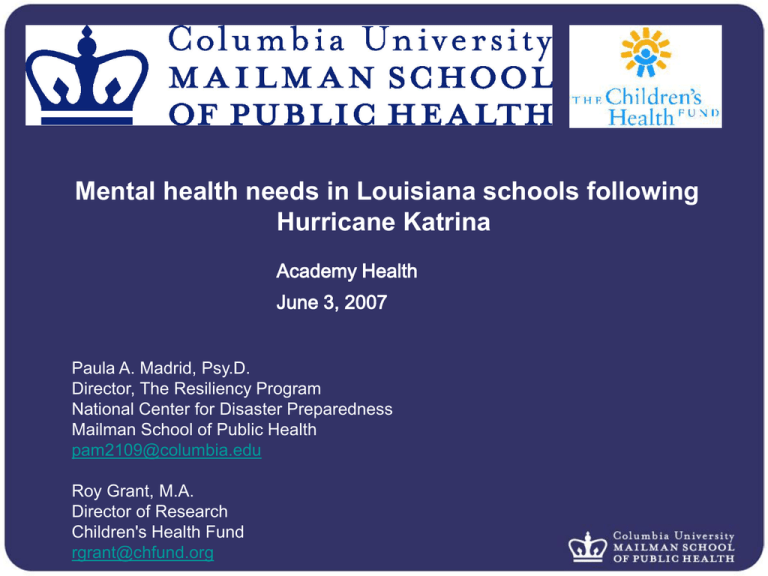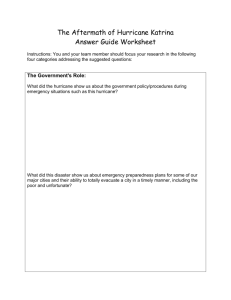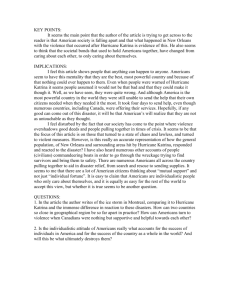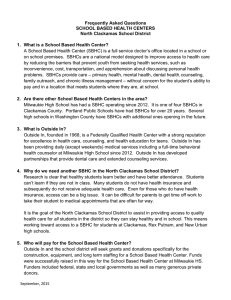Mental health needs in Louisiana schools following Hurricane Katrina Academy Health
advertisement

Mental health needs in Louisiana schools following Hurricane Katrina Academy Health June 3, 2007 Paula A. Madrid, Psy.D. Director, The Resiliency Program National Center for Disaster Preparedness Mailman School of Public Health pam2109@columbia.edu Roy Grant, M.A. Director of Research Children's Health Fund rgrant@chfund.org School-Based Health Centers (SBHCs) • Important health access points for medically underserved children • Provide care to 2 million children in 44 states • Reduce hospitalization and emergency room use for their patients • School-based mental health interventions are as effective as community clinics – Intervention on-site bridges access to care barriers SBHCs in Louisiana, Pre-Katrina • Large school-based health center network • 56 sites throughout the state • ~ 42,000 enrolled students In Louisiana, More Than Half of SBHCs Serve Rural Communities 46 rural 54 urban In Louisiana, 3/4 of SBHCs Serve Elementary and Middle School Students 9 22 elementary middle mid-high high K-12 24 29 16 The Impact of Hurricane Katrina • Directly impacted 90,000 square miles – About the size of Great Britain • Directly impacted ~1.5 million people in Louisiana, Mississippi, and Alabama • In the aftermath, FEMA provided temporary housing to 85,000 households • Current estimates place the number displaced children at ~150,000 • More than 700 schools were damaged or destroyed Operation Assist • Special initiative of The Children’s Health Fund and National Center for Disaster Preparedness, Mailman School of Public Health (Columbia University) • Direct delivery of medical and mental health services to affected regions – Use of mobile medical units to reach isolated and underserved communities • Public health assessment and planning in Louisiana and Mississippi Study 1: SBHC Needs Assessment Immediately After Hurricane Katrina • Focus group in Lafayette Louisiana held within 2 weeks of Hurricane Katrina – Co-led by a physician, a psychologist, and a school safety specialist who had assisted in the evacuation of NYC schools on 9/11/01 • Open-ended questions • Responses recorded in writing and analyzed for trends • Three group trainings subsequently provided and evaluated Participants • 32 representatives from 24 Louisiana SBHCs located in the hurricane-affected area – Health and mental health providers, and administrators • Some participants had lost their homes in the hurricane • Most were from sites distant from the hurricane-impacted area • Some had done rescue and recovery work immediately after the hurricane • Most SBHC sites included evacuee children Principal Findings: Training Needs of SBHC Staff • Most powerful theme: Help the helpers – Provide support to professionals and volunteers caring for families affected by a disaster • Training on identification of trauma • Training to work directly with traumatized children and families • How to protect confidentiality and arranging consent for services when children are separated from their parents • How to most effectively support teachers Principal Findings: Training as Advocates • Strong concerns about meeting new levels of need – One city grew in population from 21,000 to 24,000 in under a week – One school enrolled 143 new students in 4 days – The affected communities had not been adequately served for health or mental health care before Hurricane Katrina – Access to specialists highlighted as a problem because this was difficult before Katrina • Ensuring that service expansions are sustained – Requested training in fund raising and advocacy Evaluation: What Worked Best in the Training? • Interactive and experiential sessions • Group discussions • Allowing time for self-reflection • Focus on stress management Evaluation: Further Training Requested About… • Child mental health problems – – – – – Depression Posttraumatic stress disorder Bipolar disorder Self-injurious behavior Eating disorders • Appropriate clinical assessment tools • Child psychotherapy techniques – Brief cognitive-behavior therapy – Videos of therapy sessions would be helpful • How to deal with stigma associated with mental health problems • Different approaches based on child’s age and developmental level • How to best involve the family Study Two: Student Needs ~6 months Post-Katrina • Survey instrument distributed to 43 schools – Responses from 42 schools; 98% response rate • 19 (45%) schools categorized as “high displacement” – > 100 displaced students, or – > 10% increase in enrollment • 23 (55%) were categorized as “low displacement” • Average school enrollment, 937 students – Most had a total enrollment of 500-800 Increase in SBHC Patient volume • 12% of all students in the 42 schools were hurricanedisplaced children – Range per school, 9 to 850 • 75% of the displaced were in 14 (33%) of the schools • Half (53%) of SBHCs reported an increase in patient volume – 18% of those reporting an increase considered it to be “large” Reported Increase in Student Behavior Problems • Student verbal arguments, 76% • Physical fights, 64% • Truancy, 55% • Disruptive behavior, 43% • Reported parental conflict, 36% • Sexual promiscuity, 31%. Also Reported as Increased • Anger and grief • Family disruption and domestic violence • Somatic symptoms (non-specific headache and stomach ache) • Sleep disturbance (hypersomnia and insomnia) • Suicidal ideation M or e ex P W on fli ct ea po ns isc ui ty C ro m ar en t O ua nc y on du ct D M or e S P C Tr en ts Fi gh ts rg um M or e M or e M or e A M or e M or e Percent Negative Behaviors Among Students 100 80 Schools With Few Displaced 60 40 20 0 Schools With Many Displaced Families Needed Concrete Services • Mental health providers reported not being prepared to respond to basic family needs – Locating housing – Food assistance – Financial resources Conclusions • A significant increase in students with problem behavior and other signs of emotional distress can be anticipated following a disaster • Evacuation and relocation after a disaster increase its negative impact on child and adolescent mental status • School and SBHC staffs require sufficient resources and support to do their work and to manage their own losses and trauma • Training on assessment and treatment of psychological trauma is needed including for mental health professionals • Sustained efforts are required to ensure that the availability of services meets the increased level of need following a disaster







